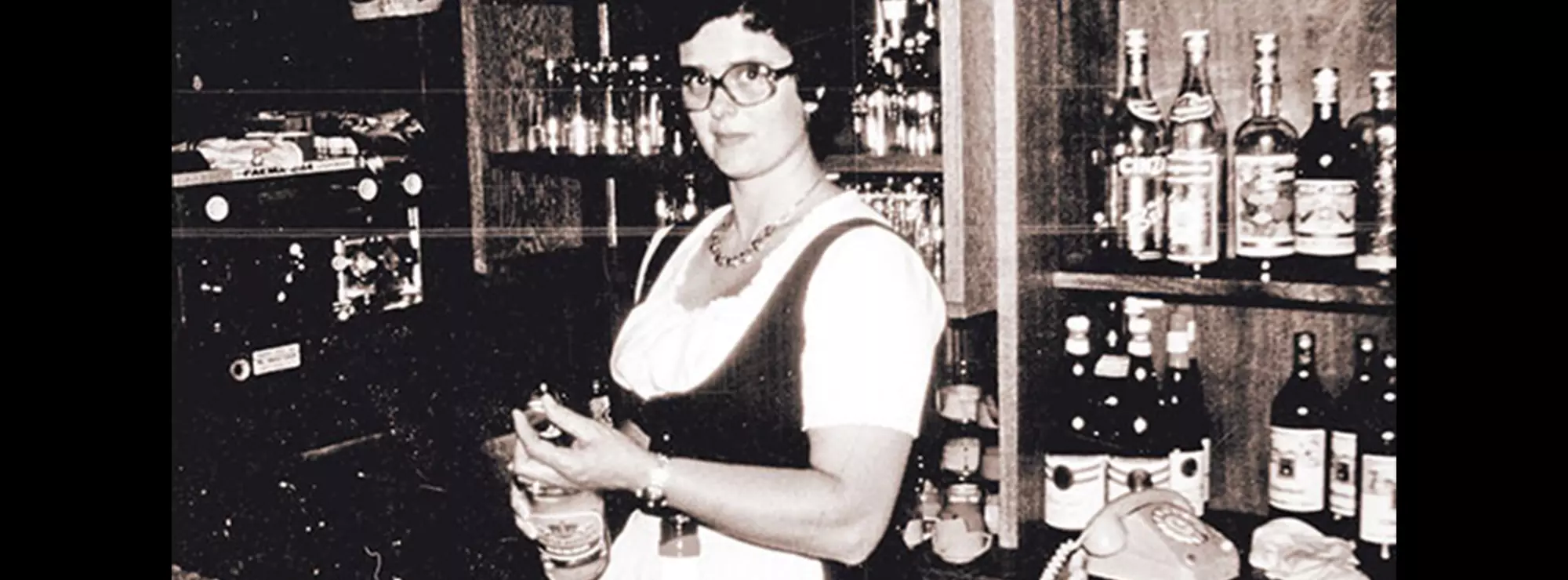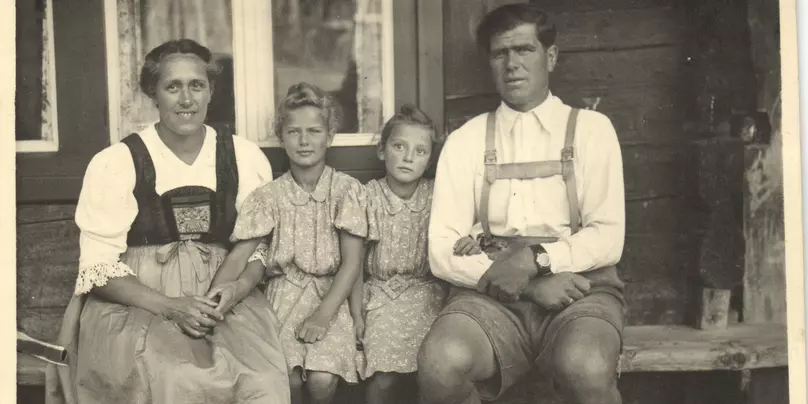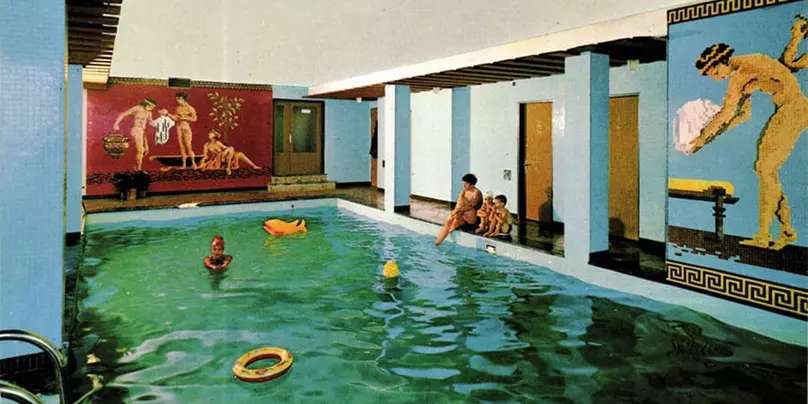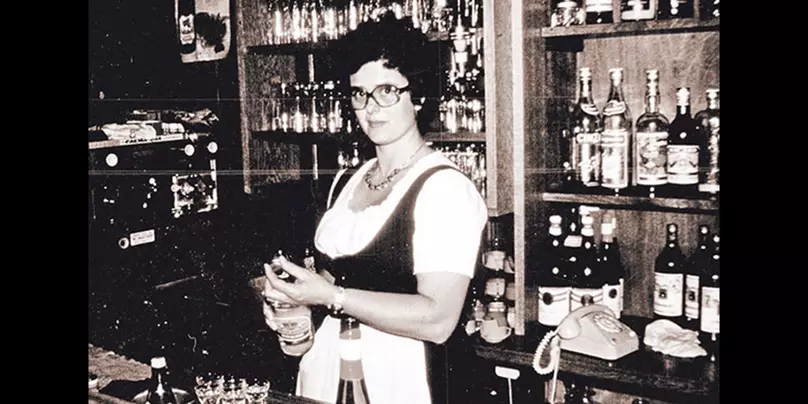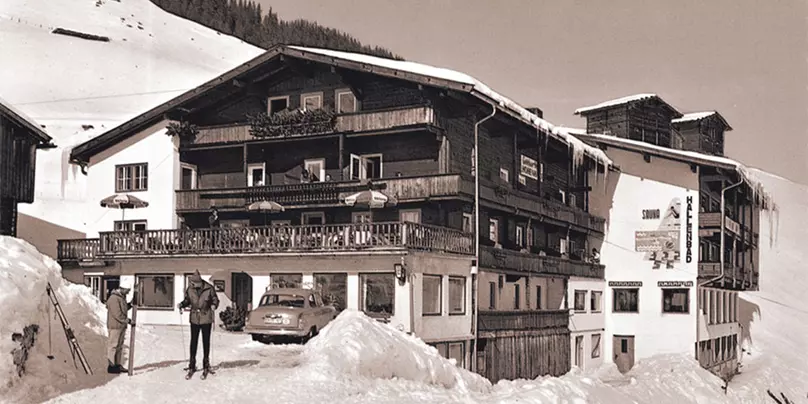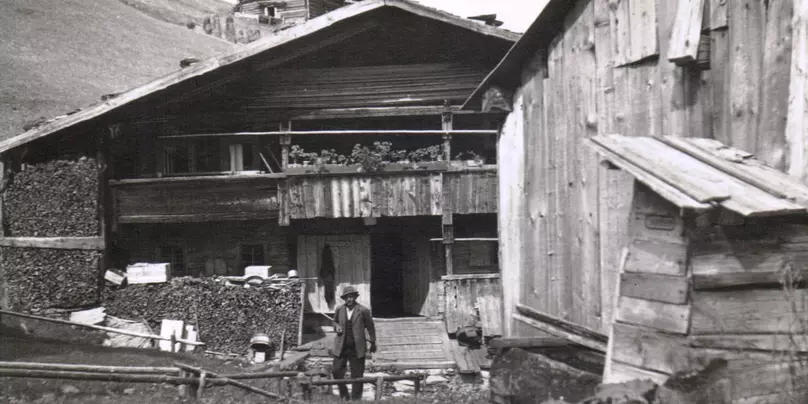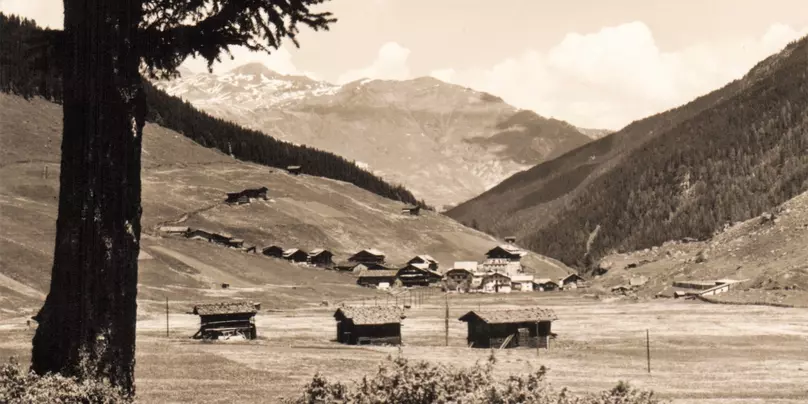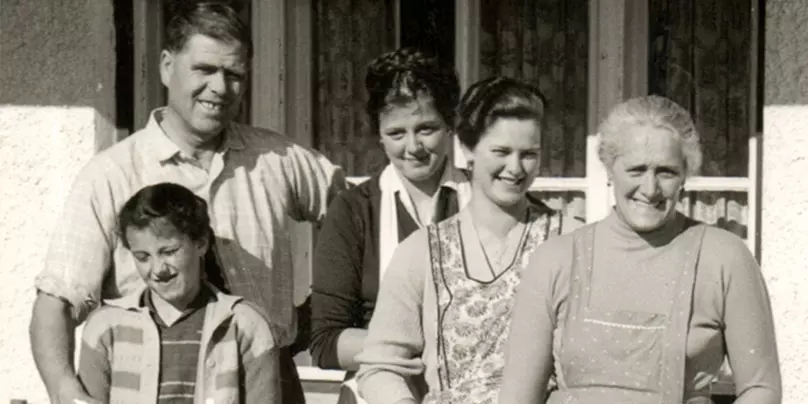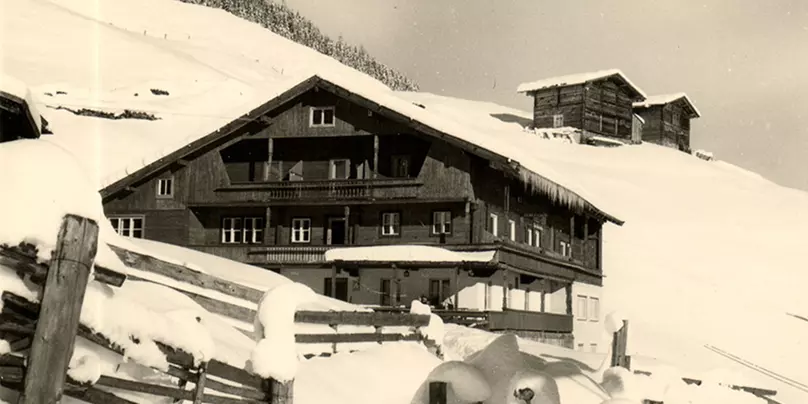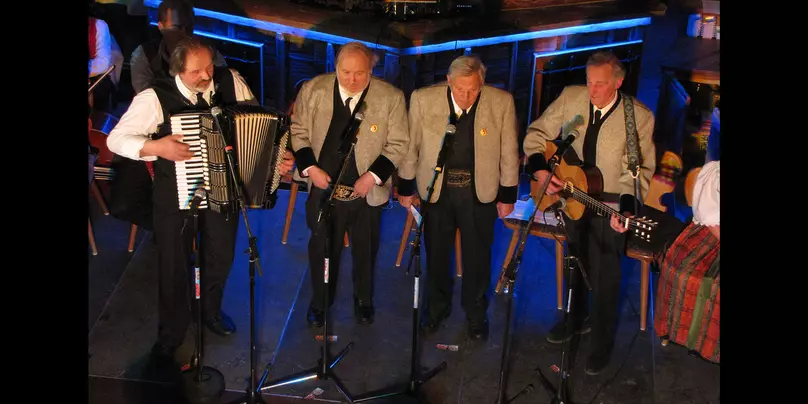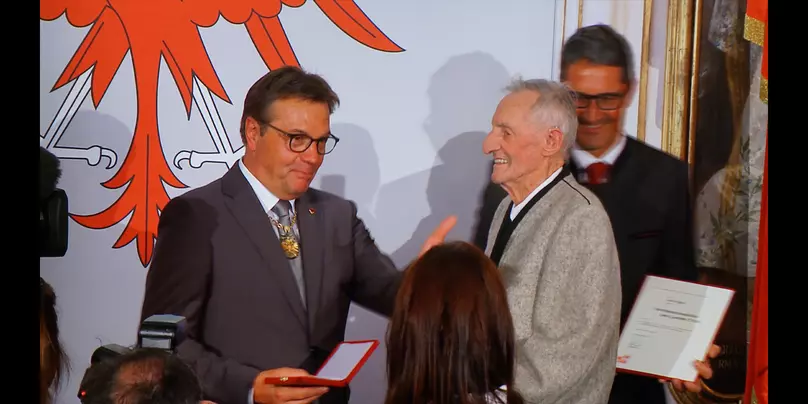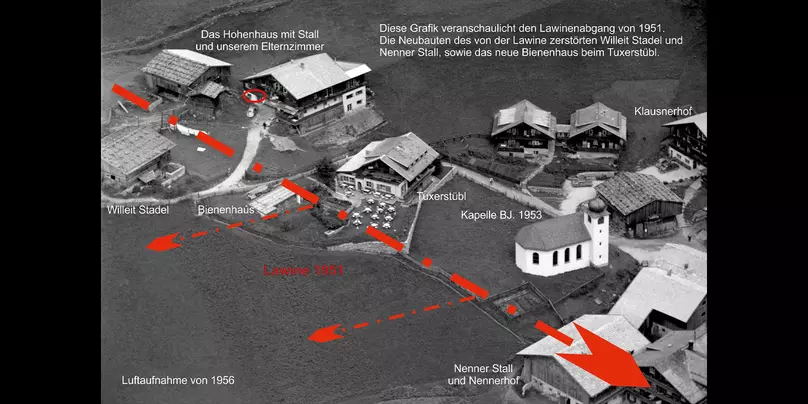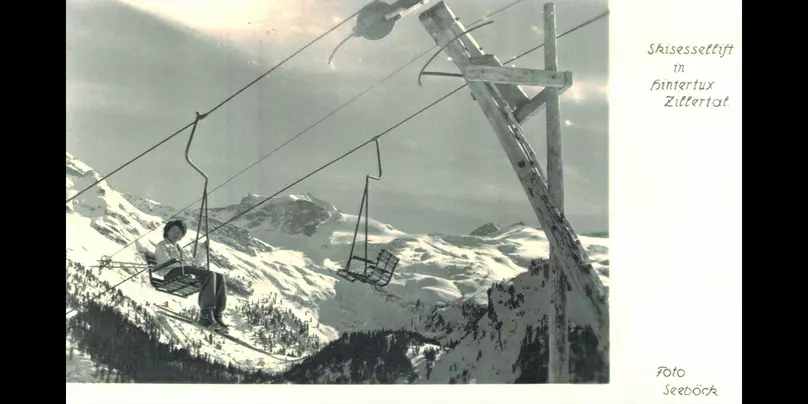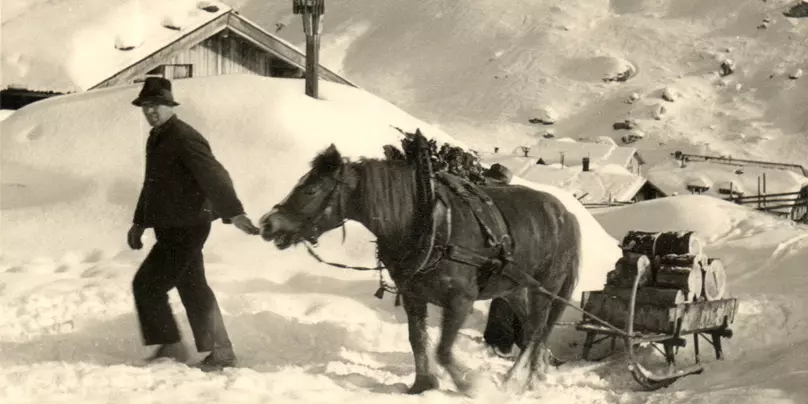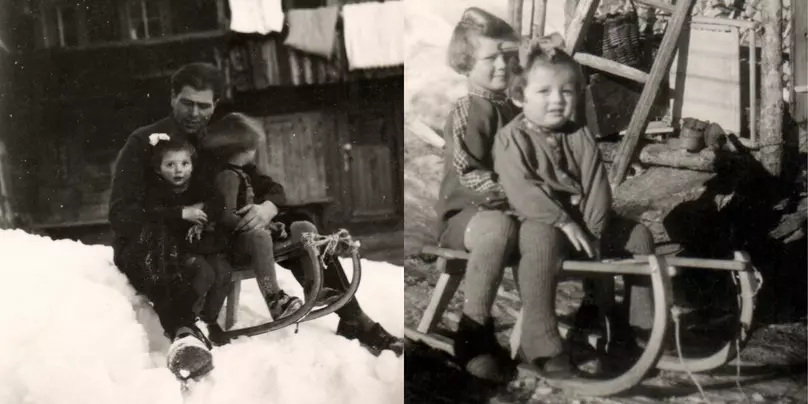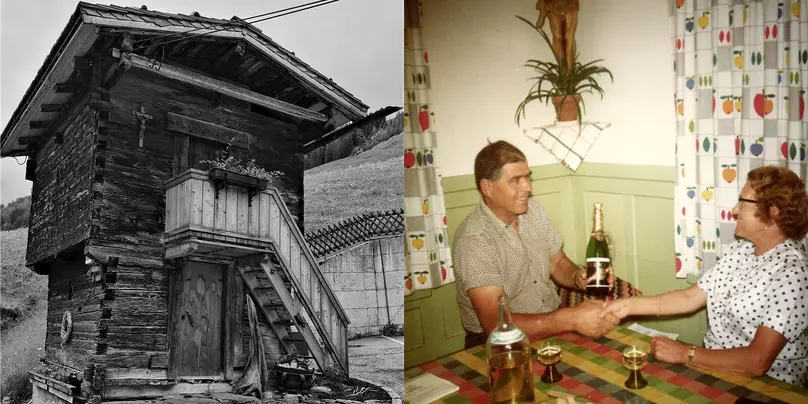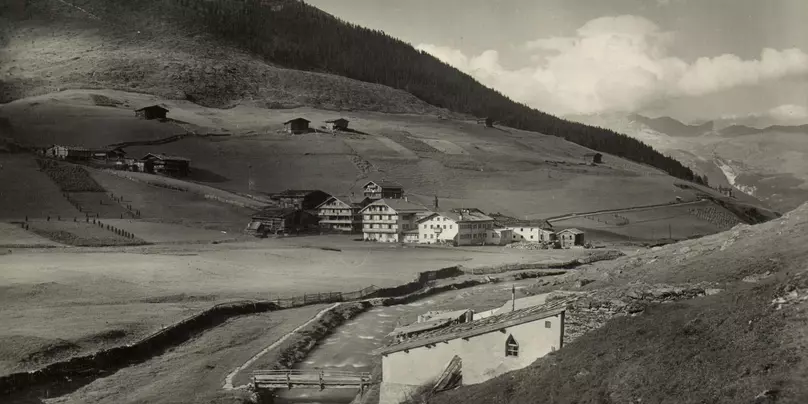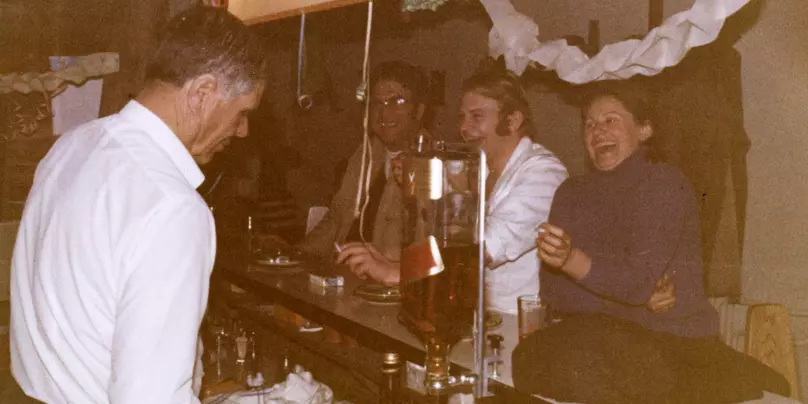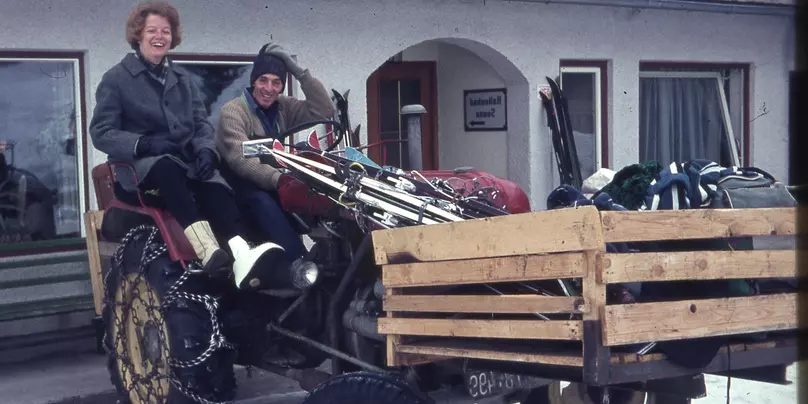Wilma
Wilma 1
Part 1 - 2011
How it all began! Innkeeper Wilma talks about days gone by
Today I would like to tell you about my parents and the first guests at Hohenhaus.
read more here
The small mountain farm at Hohenhaus was painstakingly developed into a "guesthouse" by my parents Anna and Hermann Wechselberger and was constantly being developed. The first private indoor swimming pool in the entire district was built in 1965. As well as rooms with "running water". 1920
the first tourists came to the then not very comfortable "Erbhof Hohenhaus" for summer holidays or mountain climbing. At that time, the Hintertux thermal baths were a special attraction. The Hintertux water was said to have healing effects for all kinds of ailments. Our first regular guests were the Steinlechner family from Wattens in Tyrol. At that time there was no road to the Tuxertal valley and so the family came to Hintertux in a strenuous day's walk through the "Wattener Lizum" (a side valley of the Inntal valley), over the Geierspitz and Wandspitz.
The daughter Agnes Steinlechner, who was very young at the time, remained loyal to us for over 75 years before she passed away at the proud age of 96. In the 60s, the winter seasons became more and more attractive with the construction of the first lifts in Hintertux. My father Hermann was a great pioneer and far ahead of the times.
He was also instrumental in the founding and further development of the lift. The first chairlift was built in Hintertux as early as 1949. The "Bahn" became the first Tyrolean glacier ski area at the end of the 1960s and the Hintertux Glacier is still the only year-round ski area in Austria. My mother Anna came from the Nennerhof in Hintertux. She died after a serious illness in March 1978. My father Hermann came to Hintertux as an orphan, where he was adopted by the Hohenhaus farmer's wife.
He died shortly after my mother after a heart attack in September 1978. From then on it was up to me to develop the farm further. I will tell you these and other stories in the next issues of the "Hohenhauser".
Yours, Wilma
Wilma 2
Part 2 - 2013
Continuation of the origin story
Now it was up to me to refurbish the "Pension Hohenhaus" (without a star), which dated from the 1950s and was no longer up to date, and to turn it into a hotel. And so I took this big step in 1980 and rebuilt the 4-star Hotel Hohenhaus with 130 beds.
read more here
Now it was up to me to refurbish the "Pension Hohenhaus" (without a star), which dated from the 1950s and was no longer up to date, and to turn it into a hotel. And so I took this big step in 1980 and rebuilt the 4-star Hotel Hohenhaus with 130 beds. In many ways, the new Hotel Hohenhaus was a pioneer in the entire industry. For example, we built the Kaminhalle and the Jägerstube with the old wood from our old cowshed. We were the first hotel in the world to install exclusively energy-saving light bulbs. We also installed the heat pump system, which was new at the time, but unfortunately it never worked properly. The first seminar room in the entire region was set up and every room already had a TV set (without remote control and only with 2 ORF programmes) and a room safe. Satellite programmes did not yet exist.
And this investment had its price and the loan had an interest charge of around 12%. The first years were very difficult and labour-intensive. Due to the small staff of only 13 (I couldn't afford more), I was practically on duty day and night, 365 days a year. From cleaning rooms, washing dishes, bar service, kitchen service to bookkeeping and correspondence.
Wherever there was a need, I had to step in. The first two years the accommodation was also poorly occupied because many regular guests could not afford the price leap from a private guesthouse with rooms with running water to a 4-star hotel. This was also difficult for me personally, as many of these regular guests had grown very close to my heart. It took about 3 years until new regulars started to frequent the Hotel Hohenhaus. And so we recovered very quickly from the big investment and many more followed, such as the squash hall, the parking garage, the "Tux 1" (PapperlaPUB) and a big reconstruction of the indoor swimming pool (adventure pool El Paradiso).
The "El Paradiso" has meanwhile given way to the "Alpenbad Hohenhaus" and the "Alt Hintertux" sauna village. And so it has gone on and on until the present day. We are constantly renovating and modernising. Last summer we renewed the entire heating system including controls and switched to environmentally friendly pellets. A new ventilation system was installed in the hotel bar area. Likewise, 12 rooms and the toilet facilities on the ground floor were brought up to date.
Yours, Wilma
Wilma 3
Part 3 - 2014
Our family
My mother comes from the "Nennerhof" in Hintertux. She was the good soul in the Hohenhaus for many decades as a farmer's wife and landlady. Especially during the war years, she had to achieve incredible things and endure a lot.
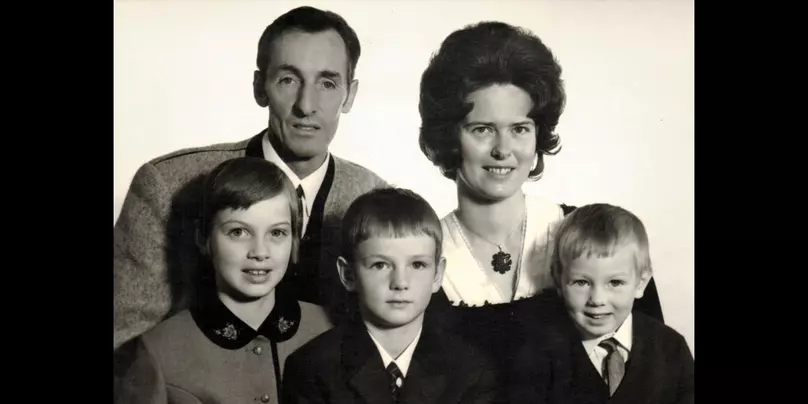
read more here
My mother comes from the "Nennerhof" in Hintertux. She was the good soul in the Hohenhaus for many decades as a farmer's wife and landlady. Especially during the war years, she had to achieve incredible things and endure a lot. My mother was a strong personality and had incredible stamina.
My father lost his parents as a small child and therefore spent his early childhood in an orphanage. Escaping from the orphanage, he came to Hintertux via many detours, where he hid and struggled as a shepherd boy. The childless "Hohenhauser Bäuerin" took great pity on the totally neglected child, so that she took him in and adopted him. Later she signed the "Hohenhauserhof" over to him. My father was a cable car pioneer from the very beginning and played a decisive role in the development of the Hintertux glacier. Without his work, there would be no glacier cable car today and probably hardly any tourism in the Tuxertal valley. I was born in 1940 and grew up with my two siblings in very simple and sometimes poor conditions on a mountain farm. Even as children we had to work hard. Nevertheless, we had a very beautiful and carefree childhood. Unfortunately, my parents died much too early, within half a year, in 1978.
As the eldest of the three sisters, I was allowed to take over my parents' farm. In 1959 I married "Siegeler Max" Egger, who came from Mayrhofen. He owned the "Siegelerhof". Now my daughter-in-law Antonia manages the farm in Mayrhofen. We have leased out the alpine pasture belonging to the Siegelerhof and the "Hotel Siegelerhof".
My husband Max comes from a very musical and long-established Mayrhofen family. His father taught him to sing and play the guitar. The "Familienmusik Egger" was the first music group he belonged to. Later he founded the legendary "Mayrhofner Trio" with 2 friends. In the fifties they were the "Schürzenjäger" among the folk music groups. You could hear them on every German-language radio station, even music legend Ernst Mosch recorded some music titles with the trio. On the tiled stove (hotel bar) hang some pictures on this theme. After we got married and spent a summer in Mayrhofen, we moved to Hintertux. Max looked after the cows and pigs at the Hohenhauserhof and joined the "Tux Singers". For over 50 years, this music group was very popular and travelled a lot accordingly. At the age of 92, Max still loves to sing.
Our marriage resulted in 3 children. The oldest is Martina, followed by Hermann, last but not least came Sepp. In 2012 Martina created her own mainstay with the "Ferienwohnungen Egger". Hermann and Sepp took over the Alpenbad Hotel Hohenhaus with the associated businesses and the farms in Hintertux and Mayrhofen. I have four grandchildren and one great-grandchild who give me a lot of joy. I am happy about every day that the family is healthy and we can live together in harmony and peace.
I wish you the same health and harmony and look forward to seeing you again in the Hohenhaus. In the next issue I will tell you a bit about the Tuxertal, especially about Hintertux and the development of the glacier cable car.
Yours, Wilma
Wilma 4
Part 4 - 2015
"Hohenhaus Seppal“
"Hoachnhaus Seppal" (Josef Wechselberger) was the planned takeover of the Hohenhauser Hof. However, Seppal was caught poaching several times.
read more here
"Hoachnhaus Seppal" (Josef Wechselberger) was the planned takeover of the Hohenhauser Hof. However, Seppal was caught poaching several times. Hunting at that time was reserved for the nobility and manors, poachers were punished with heavy imprisonment. For the local population, it was not the trophy that attracted them, but the meat of the wild animals. For Seppal, "doing time" during the intermonths was not a bad thing, because it was warm and there was something to eat. to eat. At home there was more food for his parents and siblings. Especially in the winter months, food was very one-sided and scarce. Hintertux was the "poorhouse" in the Zillertal. Year after year it was a matter of survival and there were no alternatives. The wild nature, the long winters and the one-sided food and the unbalanced diet put a heavy strain on the population. There was no doctor and therefore an appendicitis, a broken bone or a simple flu was often the cause of death. or a simple flu was the death sentence. Seppal and his father Thomas were not aware of the fact that a convicted "criminal" could not take over the farm. Out of this bitter realisation, Seppal had to leave the had to leave the Hohenhauser farm. His father gave him all his savings so that his son would be able to leave the Zillertal. to get out of the Zillertal. For many years the people of Hohenhaus heard nothing from Seppal. In February 1913 a letter arrived letter arrived with a strange, unknown sender:
Leadville,Colorado,Box 506
Greetings, my father!
I hope you are all well and not suffering too much hardship. I also hope that you are all in good health. I have emigrated to Colorado. I got more land from the American government than all the farmers in Hintertux own together. And I no longer have to go to jail for poaching, because I can watch the deer from my kitchen window. I can shoot the deer from my kitchen window! I am married to an Indian woman and we have seven healthy children. By order I will send you 320 dollars, which is the value of 1,000 crowns. I'm sure you need the money more than I do. I thank you all my life and wish you prosperity and health.
Yours, Seppal
In the letter was a picture of Seppal with his family. They were all sitting or standing on a combine harvester! Never before had a Hintertuxer had ever seen a combine harvester. These lines impressed my father so much that it was his greatest wish to meet this personality. was to meet this personality. Unfortunately, it did not come to pass, because my father died much too early. Thomas Wechselberger handed over the Hohenhauser Hof to his daughter Maria, as all his male siblings were no longer alive. were no longer alive. Maria was single and had no children. She adopted my father, who had already been orphaned as a child. orphaned. So he became the farmer at Hohenhauser Hof.
Yours, Wilma
Wilma 5
Part 5 - 2016
My childhood
I was born on 28 August 1940, the eldest of three daughters. My sister Ilse was born in 1943, Christl followed in 1950. My childhood was marked by poverty, hard work, but also by the security of the family circle at Hohenhauser Hof.
read more here
I was born on 28 August 1940, the eldest of three daughters. My sister Ilse was born in 1943, Christl followed in 1950. My childhood was marked by poverty, hard work, but also by the security of the family circle at Hohenhauser Hof. There was no running water and no central heating. There was an outhouse on the balcony. In the first years of my life I cannot remember seeing my father. He had to go to war in 1942. For my mother, this was the hardest time in her life. She had to cope with the hard men's work alone. The winters were snowy and cold, the food one-sided and scarce.
In the summer of 1946, we were harvesting hay when two sinister men approached us. My sister Ilse and I were very afraid of these dark figures, but our mother ran towards the men and hugged one of them. It was our father, who had escaped from captivity in Russia. The first days together were unusual because he was a stranger in our eyes. For our mother it was probably the greatest happiness in her life.
For a long time she didn't know if he was even still alive. Some time later the gendarmerie came and arrested him. He had to go to Brixlegg for forced labour, where he was imprisoned in a penal camp. From 1946 I was allowed to attend school.
The school building was where the "Minimarkt" in Hintertux is today. There was only one class, in which all 8 grades were accommodated. The teacher was very strict, we had great respect. Before I went to school in the morning, I had to feed and milk the goats in the stable. Later, when my younger sister Ilse was big enough, I was responsible for the cows and Ilse for the goats. In the summer we helped with the field work, in the stable and in the household. But especially in winter we also had good times. What I remember positively is how we were allowed to go tobogganing every Sunday to the church service in Lanersbach. I will never forget the smell of the warm rolls we got at the bakery after church.
And so the years passed, we grew up and the small mountain farm with three guest rooms became a "guesthouse for tourists", later a hotel.
Yours, Wilma
Wilma 6
Part 6 -2017
The development of the Gletscherbahn
My father had a formative childhood full of strokes of fate and poverty. After the death of his parents, he and his siblings were distributed in various orphanages in Tyrol and South Tyrol.
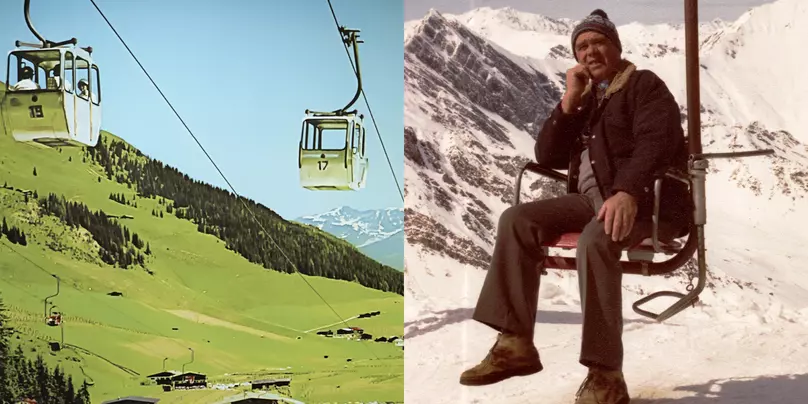
read more here
My father had a formative childhood full of strokes of fate and poverty. After the death of his parents, he and his siblings were distributed in various orphanages in Tyrol and South Tyrol. Terrible conditions must have prevailed in the orphanages, so he fled at the age of 13 and finally reached Hintertux. Decades later, the childless Hohenhaus woman handed over the farm to him.
Life was characterized by hard work, there were no great prospects. The only thing that mattered was the provision of food. The hope for improvement was the burgeoning tourism after the war. In July and August guests came "for summer freshness". These guests slept in the rooms of servant and maid. These had to sleep in the barn during the two months. So money came to the village, so that in 1949 some Hintertuxer decided to found the "ski lift company Hintertux". The first chairlift was built with much courage, idealism and everything that was saved. Everything had to be improvised. The chairlift supports were made by hand from wood. The technical parts came from old military stocks. The drive was a tank engine. But the first setback was not long in coming. In January 1951 an avalanche destroyed the chairlift. From the rubble, the lift was repositioned on an avalanche safe place. However, this location proved unsuitable because the lift was too far from the village and food supply. In 1954, the lift had to be discontinued due to economic difficulties and technical defects. With the last available funds the Hintertuxer built a drag lift near the village. As the years went by, the demands of skiers increased. A single drag lift was no longer viable. Due to the danger of avalanches, however, there was no possibility for expansion at this location. And so the Hintertuxers ventured a very last attempt, which only 5 Hintertuxers wanted to support. Even the community Tux was not ready to join as a shareholder. All forecasts by experts were negative. House and farm were pledged as collateral to the bank. In 1965, with the last of all strength and all adversities, a chairlift, the "Liftstube" and in 1966 another drag lift were built. At that time, nobody suspected that the development of the Sommerbergalm would be the basis for a thriving tourism region on the Hintertuxer Glacier. The society grew year after year, the glacier was developed, slopes built. In addition to the Hintertux Glacier cable car companies and restaurants in Lanersbach, Vorderlanersbach, Finkenberg, Ehrwald and the Zugspitze were taken over or rebuilt. Today, the Zillertal Gletscherbahnen GmbH & CO KG is one of the largest cable car companies in Austria.
My father was a visionary, technology excited and very hard-working person. He was the first Hintertuxer who owned a bike (there was no road yet), motorcycle, tractor, mower, washing machine or a car. In 1966 we were the first in the entire district to build an indoor swimming pool and a sauna. He was also instrumental in setting up and developing the Gletscherbahn from the very beginning. He was where he was needed. As an elevator guy, mechanic, piste equipment driver, builder or idea generator. Until the end of his life in 1978 he was an enthusiastic cable car man.
Yours Wilma
Wilma 7
Part 7 - 2018
My Husband Max
Max Egger was born in 1922 at the parental "Siegelerhof", the first documented mention of Mayrhofen. In records of the parish, we found the following, interesting entry: "Wolfgang Egger was already in 1677 a sacristan in Mayrhofen
read more here
Max Egger was born in 1922 at the parental "Siegelerhof", the first documented mention of Mayrhofen. In records of the parish, we found the following, interesting entry: "Wolfgang Egger was already in 1677 a sacristan in Mayrhofen. The office of the sacristan and also the position as a teacher remained in the Egger family for about 170 years. The family seems to have been very much respected. It also becomes apparent from the many requests for registry certificates that the family was very widespread and today many descendants from this family can be found in many locations". Max had 5 sisters and one older brother. All children had to sign with their father from a young age. His father played the zither and was a gifted musician. Max also proved to be very docile and learned to play the guitar in self-study. Music was to accompany his throughout his entire life. Besides the music, the 2. world war has also had an effect on him. With two gunshot wounds, Max was still lucky that he got away with his life. His older brother died in the last days of the war. It was not until December 24th, 1947 that Max returned home from captivity. Having just arrived home, he and 2 friends founded the legendary "Mayrhofen Trio", with whom they performed in half of Europe. This formerly very well known trio existed until 1960. In the summer months, at the Sieglerhof (farm) and in the guesthouse, there was enough work for him and his sisters. In the winter, the kids had to work elsewhere. This way I met Max in the winter of 1958 in the Hintertuxer Alpenhof, where he worked as a janitor. We got married in 1959 in the Hintertuxer chapel and as it was back then, I moved in with my husband in Mayrhofen. I was just 20 years old when in 1960, our daughter Martina was born. Due to lack of work, we moved to Hintertux in the winter.
Our guesthouse "Fremdenpension Hohenhaus" had heating, so that it was also possible to rent out rooms in the winter. Max took care of the cows and pigs and wanted to stay in Hintertux year-round. We had two more sons, Hermann in 1963 and Sepp in 1968. After the death of his parents, Max rented out the Sieglerhof to a travel agency and the farm to a neighbor. The Sieglerhof and the farm with the alpine pasture are still family property. Max was a farmer in Hohenhaus, but his passion was music alone. Max was traveling with his "Tuxer singers" a lot. The musical group existed for over 50 years. He liked company and understood how to make others happy. For his commitment in the field of traditional folk music and the preservation of old songs he received the cultural honor of the Tux municipality. In 2017, Governor Günther Platter presented him with the Medal of Merit of the state of Tyrol. Max was never sick and mentally fit right to the end. In October 2017 he sang for the last time in the occasion of his sister's birthday. In November he drove his car for the last time. In December, he no longer wanted to leave his room. Max died peacefully on January 8th, 2018 at the age of 96, in his home, as he wished. He had a fulfilling life and was a peace-loving and good-natured person. His seat in the room and at the fireplace will now forever remain empty. We miss him dearly.
The bright voice has fallen silent, the sound is no longer the same.
We preserve your legacy with respect, death is not the end"
Your Wilma
Wilma 8
Part 8 - 2019
Avalanche in 1951
As this past winter saw more snow than we have seen in a long time, it brings back my memories of the snowy winters of my childhood. The smaller and larger avalanches coming down from both sides of the valley were nothing out of the ordinary. But I will never forget the avalanche winter of 1951. I was just 11 years old
read here more
As this past winter saw more snow than we have seen in a long time, it brings back my memories of the snowy winters of my childhood. The smaller and larger avalanches coming down from both sides of the valley were nothing out of the ordinary. But I will never forget the avalanche winter of 1951. I was just 11 years old. My father made weather records of that winter, which makes an accurate reconstruction possible. The first snowfall came on 26.10.1950, after that it snowed again and again until Christmas. On 04.01.1951 1.50 meters of snow fell, from 18.01. to 22.01.1951 again 2.50 meters. My father had constantly measured the snow increase and showed concern. I felt that this year was exceptional, everyone was afraid.
On 19.01.1951 it came, the "century avalanche"!
All the people of Hintertux knew that these enormous amounts of snow would come down. That's why we were not allowed to leave the house and had the day off from school. On 20.01.1951 at 16 o'clock came the "Inner Wall Avalanche". At 11 p.m. it began to rush eerily again. My little sister Ilse and I slept in our parents' room. Full of fear we ran to the parents' bed. They held us tightly in their arms to comfort us, perhaps also to protect us. The noise became louder and louder, the floor and the walls began to vibrate, the windows shook as if they were about to burst. No one spoke a word until it became quiet again. We were shaking all over. We could not see anything through the windows, they were "cemented" by the snow. We knew very well that we had only very narrowly escaped a catastrophe. The next morning we saw how close this avalanche had come to our house. I was allowed to walk across the avalanche cone with my father. Our barn just withstood the enormous pressure of the avalanche. The wooden walls facing the avalanche were crooked from the enormous pressure of the avalanche. The ancient "Willeit-Stadel", which stood directly in front of the Hohenhaus, had disappeared, as had numerous other hay barns belonging to us and to Hintertux farmers. At the Tuxerstübl, our neighboring house, the bee house was swept away, a tree trunk bored through the window into the children's room. At the Badgasthof, the avalanche had penetrated the house, the dining room was completely destroyed. The stable of my mother's parents' house, the "Nennerhof", was completely destroyed. All cows, pigs and goats were dead. The "Nennerhaus" was buried up to the second floor. And we also saw that the chair lift, which was put into operation on 18.12.1948, was completely destroyed. My father was a partner and one of the initiators of the lift. In addition to the financial setback that threatened our existence, the tourist development of Hintertux was now also in question. On the way home to the Hohenhaus, an avalanche suddenly came from the opposite side of the Schmittenberg. My father threw himself on me. The pressure of an avalanche can tear your lungs apart. My father could only keep me on the ground with great difficulty, I could hardly breathe. When things calmed down again, we were lying under a few inches of snow dust. We stood up, shook ourselves off, and saw nothing. All around was white snow dust. We started walking uphill until we were safe in our house. My father was visibly in shock. Miraculously, there was no loss of life in Hintertux. Triggered by further large avalanches in 1953 and 1962, an avalanche deflection dam was built in the valley, which was to prove its worth for the first time immediately after its completion in 1969. In the meantime, most of the avalanches in the breakaway areas have been blocked. After the enormous snow masses in this year's winter, we can assume that no more large avalanches will occur in Hintertux. Lastly, I would like to relate what has been passed down through many generations. My parents told me that the first settlement of Hintertux was over the Tuxerjoch. The first huts stood on the Sommerberg. As various field names prove, the first settlers were miners who prospected for gold and silver. These miners made the land on the valley floor arable and built the first farms and stables near the glacier lift valley station. In 1405, a momentous catastrophe occurred. A mighty avalanche cost many lives and completely wiped out some family tribes. The survivors rebuilt, but a little further out of the valley, where the village center is today. Unfortunately, the village chronicle from that time was destroyed by a fire in the rectory, so there are no written records left. However, various field names and the "3 crosses" at the head of the valley provide clues that the oral traditions and accounts may have been something like this. Finally, I would like to tell what has been handed down over many generations. My parents told me that the first settlement of Hintertux was over the Tuxerjoch. The first huts stood on the Sommerberg. As various field names prove, the first settlers were miners who prospected for gold and silver. These miners made the land on the valley floor arable and built the first farms and stables near the glacier lift valley station. In 1405, a momentous catastrophe occurred. A mighty avalanche cost many lives and completely wiped out some family tribes. The survivors rebuilt, but a little further out of the valley, where the village center is today. Unfortunately, the village chronicle from that time was destroyed by a fire in the rectory, so there are no written records left. However, various field names and the "3 crosses" at the head of the valley provide clues that the oral traditions and accounts may have been something like this.
Yours Wilma
Wilma 9
Part 9 -2020
Christmas on the mountain farm
With fertilizing, the last field work of the year, Advent began. The work became less, the days shorter, it became quiet in the house. I was eight, maybe nine years old. Advent then was so beautiful that I don't even know where to begin.
read more here
With fertilizing, the last field work of the year, Advent began. The work became less, the days shorter, it became quiet in the house. I was eight, maybe nine years old. Advent then was so beautiful that I don't even know where to begin. Already at the first snowfall we feverishly awaited Christmas.
Full of joy, we were able to ride the toboggan to the Hintertux elementary school. It's winter, lots of snow, everything is white - and then: the comfortably warm parlor. The first Advent Sunday. What excitement. My younger sister Ilse and I were allowed to take the toboggan to the Holy Mass in Lanersbach at 5 o'clock in the morning. After the mass we got a warm line (longish bread roll) from the baker. With the warm bread we warmed our hands. And it was so good that I still have the pleasant smell in my nose. At that time it was colder than today, minus 20 degrees were not uncommon. We walked back to Hintertux. The wood-heated parlor and cozy warmth awaited us. Our parents had time to play cards with us. Christmas time was also a wonderful time because I didn't have to work in the stable. It was so beautiful, I can hardly describe it.
And then Santa Claus came with the scary Krampuses in their scary masks. We had great respect and at the same time much joy. Because St. Nicholas always brought us something. Once he had mandarins with him. We did not know this fruit, the tasting was an experience. A few days before Christmas Eve, the pig was slaughtered. My sister Ilse and I were allowed to cut the fat from which the "Groiggen" (grams) were made. During the production, lard was extracted from the pig. We had to use the lard and the self-smoked bacon sparingly. The products obtained from the pig were the annual ration. At that time we also baked cookies and tents (fruit bread with nuts). The whole house smelled of these delicacies. The highlight of the year was, of course, Christmas Eve. First we went to the early mass, at noon we had milk jam with warm honey. The whole family spooned from one pan. At dusk we had to go into all the buildings with holy water and incense.
We walked praying behind our father. This ritual was supposed to ward off bad luck from people, animals and buildings. Afterwards, we waited with our father in the kitchen. Our mother was "busy." She had to show the Christ Child where to bring the presents. Finally the bell rang. We prayed another "Our Father" and then we were allowed into the well-heated living room. In the middle stood the Christmas tree, decorated with apples and small goodies. A few candles were burning on the tree. Now, finally, we were allowed to unwrap the packages. Actually, we already knew what the Christ Child would bring. We always got doggel (loden shoes) and knitted woolen gloves with beautiful patterns. We also needed doggels because we had no other shoes and our loden shoes wore out after a year. In summer we went barefoot, we the shoes from the Christ Child. Sometimes there was also a woolen headscarf, caps did not exist at that time. Once we got ski pants, which were brought to us by guests. The next morning my sister Ilse and I slid down the slope until they were holey at the bottom. "So, now you'll have to go to church all winter with those patched pants!" Once we caught our mother secretly sewing clothes for our dolls, which then lay under the Christmas tree. That seemed a little strange to us. After the presents, we always had doughnuts and noodle soup. That was a festive treat, because we hardly ever had noodles. After the presents and the meal, we went to the neighbor children to show off our presents. And finally we went to the midnight mass. We were only allowed to stay up that late on this special day. Christmas Day was the longest, most exhausting, but also the most exciting day of the year for us children. With the turn of the year, everyday life returned. Up at 6 a.m., milking goats and cows, going to school, doing homework, some free time in the afternoon, then back to the barn, dinner and bed. UM 1948 Every child in the village had to help in the stable, in the field and in the house, that was normal. Nevertheless, we had a carefree, happy childhood. We lacked for nothing. Perhaps now you can imagine why Advent and especially Christmas Day was so special for us children. This day was the reward and a thank you for the work done in the past year.
Yours, Wilma
Wilma 10
Part 10 -2021
"The Dead Walk" over the Tuxerjoch
As early as 1850, more and more adventurers, mountaineers and spa guests came to Hintertux for the "summer retreat" because of the thermal water. Hintertux was very remote and there were no roads. The "strangers" brought modest prosperity to the Zillertal "poorhouse".
read more here
As early as 1850, more and more adventurers, mountaineers and spa guests came to Hintertux for the "summer retreat" because of the thermal water. Hintertux was very remote and there were no roads. The "strangers" brought modest prosperity to the Zillertal "poorhouse". The daughters of the farmers found work, the sons became mountain guides or carried food to the Spannagelhaus. The farms rented out the rooms where the farmhands normally slept (agricultural helpers). Meanwhile, the farmhands slept in the hay, in the "Litze". Soon there was also a village shop that supplied the tourists with provisions.
Since 1920, "Wattener Agnes" came to the Hohenhaus with her father. Agnes came from Wattens (near Innsbruck). The journey to Hintertux was a two-day walk through the Wattental valley, over the Geiseljoch to Lanersbach, where she spent the night. The next morning they continued on to Hintertux. I was born in 1940 and perceived Agnes as the first holiday guest. Later, of course, I got to know that rooms had been rented out long before. Agnes was very good at telling stories. She told about the old Hohenhausers and stories from lore that her "Hoachnhaus Tumml und Moidl" (Hohenhaus Thomas and Maria) told. I would like to tell you an old, macabre story that I have often heard from Agnes, my parents and other people from Hintertux. Did it really happen, or has it been changed from generation to generation?
"The walk of the dead to Schmirn" - a story from an old tradition that is still told today:
According to the Christian faith, the deceased could only be buried in consecrated ground, i.e. in a cemetery. Until 1483, this meant for the people of Hintertux, who belonged to the municipality and church office of Schmirn, that they had to take their deceased on a two-day walk over the Tuxerjoch, through the Schmirn Valley, to the cemetery in Mauern in the Wipp Valley (above Matrei am Brenner). Only there were they allowed to be buried. In winter, the procession of the dead over the Tuxerjoch was not possible due to snow and avalanches. Therefore, coffin boxes were prepared for the number of people who could possibly die in winter and stored in a separate building, the "Totenkasten". The death box was double-storeyed and small. In Hintertux there is still a similarly built building near the Hohenhaus. The death box stood near the Nennerhof. The empty coffin boxes were also often used to store Klorbirnen (dried apples and pears), grain or other durable foodstuffs. If someone died in the cold season, the deceased was laid to rest in one of the prepared coffin boxes and "chilled" in the death box. The temperatures in Hintertux are far below freezing in the winter months, so that the laying out of the deceased, which sometimes lasted for months, was not a problem. In January (year unknown), an old farmer from Hintertux died. He was laid in one of the prepared coffin boxes and placed in the mortuary next to the coffin boxes filled with food.
After the snow had melted, the deceased was carried over the Tuxer Joch to the cemetery in Mauern and buried there. Family members and most of the people of Hintertux followed the funeral march. During the two-day funeral procession, prayers were said constantly.
A few weeks after the funeral, an unpleasant smell of decay permeated half of Hintertux. After a long search, the cause was finally found in the burial box. The box with the toilet pears had disappeared, but the smelly old farmer was found. By mistake, the coffin boxes were mixed up and the winter apples were carried over the Tuxerjoch under constant prayer and buried there. The Lord God and the old farmer must have wished it that way. The apples went to heaven, the soul of the old farmer was allowed to stay in Hintertux.
Yours, Wilma
Wilma 11
Part 11 - 2022
My father - "The Tux shepherd"
In this issue I tell you about a secret that my father kept all his life. This story is a bit longer because I have to explain the background
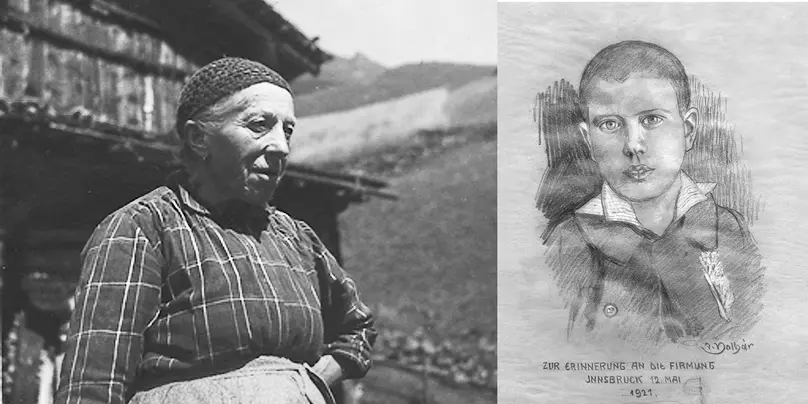
read more here
In this issue I tell you about a secret that my father kept all his life. This story is a bit longer because I have to explain the background. My father "Hermann Wechselberger-Profer" became an orphan at the age of 12. In 1915 his mother died after the birth of sister Frieda. His father Valentin died of TB in 1921. After the death of his parents, he and his eight siblings were left to fend for themselves. The older ones were able to go to work, the four youngest were divided up into various orphanages in all parts of Tyrol.
After his mother died, my father was confirmed before he was taken to a nursing home in the Stubaital. Because he couldn't stand it there, he fled over the Pardasterjoch into the Wipptal and to an alpine pasture in the farthest Schmirntal. During the summer months, a farmer employed him as a shepherd on the remote "Kluppenalm". After the alpine season in autumn, the farmer did not want or could not "feed other people's mouths". He took him to Steinach am Brenner, to the annual "Matthäus Market". The farmer wanted to get rid of him and traded my father like a piece of cattle. He praised him as a "good shepherd" and offered him to anyone who passed by. At that time Hintertux belonged to the municipality of Schmirn, the valley between the Tuxerjoch and the Wipptal. Hintertux was therefore also part of the Steinach market, where Hintertux farmers sold cheese, cows, pigs, sheep or goats.
On 21 September 1921, Hohenhaus Maria was also at the annual St. Matthew's market in "Steinach an der Brennerstraße". She saw the neglected boy and took pity on him. Nobody wanted him, nobody wanted to "feed him through" the winter. Due to a lack of labour on the farm, the unmarried and childless Hohenhaus farmer's wife Maria Wechselberger, the "Hoachnhaus Moidl", took him with her to Hintertux, where he worked as a goat and sheep herder, and later as a farmhand on the Hohenhaus farm. The only thing the boy had was a burlap sack with his few belongings and two pictures. One picture was taken on the occasion of the baptism of his sister Frieda, this happened immediately after the death of his mother. The second was a portrait of him taken for his confirmation. This picture was taken shortly after the death of his father. He cherished both pictures throughout his life, looked at them again and again. And now I come to the secret that my father had kept to himself all his life. Hermann Holzmann (born 1906), the author of "Der Tuxer Schäfer" (The Tux Shepherd), came from Steinach am Brenner, the place where the fate of my father Hermann Profer (born 1909), later Wechselberger-Profer, took a turn for the better. The author had witnessed the "trade" at the market, was probably in the middle of the action. An event that shocked him in such a way that he would never forget it in his life. For the 15-year-old Holzmann, this event must had been so formative that he decided to write a book about it.
In order to be able to authentically recreate the story of the "Tux shepherd", he travelled to Hintertux at the beginning of the 1960s to gather impressions and explore the region. He arranged to meet with Simon Mader, the "Kössler farmer",who hiked with the author to all the places where the Tux shepherd had stayed. The author wanted to know a lot about Hintertux, my father and the Hohenhausers. During the long hikes up to the Schafalm on the Wandspitze or to the Tuxerjoch and down into the Schmirntal, Simon told him many stories, some going many generations back. In 1966, "Der Tuxer Schäfer" was first published. In the book, Holzmann describes a misunderstood love in a time when hard work, godliness and the sole rule of the farmers were the cornerstones of society. This book is of particular interest to those who know the area, because places, squares, mountains, or alpine pastures have been described in detail and one finds himself in the middle of the action. For some inexplicable reason, my father bought hundreds of these books. At that time, no one could imagine why he had spent so much money on these masses of books. Not even his own wife, my mother Anna, had an explanation. Because chance would have it, in 2019 the genealogist Hansjörg Fankhauser studied the family history of the old Hohenhausers and the history of my father. He knew the book "Der Tuxer Schäfer". One day Hansjörg Fankhauser explained to me the many connections of our family history with the "Tuxer Schäfer": "The author has mixed three generations and changed names. It is your family history and the history of your father". A little bit surprised, I picked up the book, which I had last read sometime in the sixties.
At that time I had no idea that my father had found himself in this book. - Three days later I knew: The "Tux shepherd" is my father! - While reading this book, I felt transported back to the time of my childhood at the Hohenhauser mountain farm. The "Tux Shepherd" brought back my memories, even if the "good old days" were not always so good. We are very happy that this piece of family history has come to light after so many years. At the same time, it is a great pity that my father had kept this secret all his life. He could not or would not tell anyone, for whatever reason? How I would love to ask him today about "this or that". About his childhood, the many strokes of fate, the hard time in the orphanage or about his experiences at the Steinach market. He did not like to talk about these things. It was probably the worst time of his life. Despite the difficult years in his childhood, my father managed to start a family. He worked diligently and was finally able to take over the "Hohenhauser Hof" from his foster mother. From the old mountain farm he and my mother developed the "Fremdenheim Hohen-Haus", later the "Pension Hohenhaus". He was involved in the founding and construction of the Hintertux glacier cable car, and in this sense contributed significantly to the development of the Tux tourist region. My father lived a happy, busy, life. He was a respected person and held in high esteem by everyone. Calm, level-headed, honest, every word was considered. In contrast to my father, I was able to spend a beautiful childhood in the circle of my family, which I also like to tell about. I had parents from whom I was able to learn an incredible amount. They shaped my life and made me strong. I wish you all the best.
Stay healthy and visit us again soon.
Your Wilma Egger
Wilma 12
Part 12 - 2023
My Family and the Guesthouse
In the 1960s, a single drag lift was no longer sufficient. For skiing beginners, the pioneers of the "Schiliftgesellschaft Hintertux" built a second drag lift at the valley end, where the valley station of the Hintertux Glacier Cable Car is located today.
read more here
In the 1960s, a single drag lift was no longer sufficient. For skiing beginners, the pioneers of the "Schiliftgesellschaft Hintertux" built a second drag lift at the valley end, where the valley station of the Hintertux Glacier Cable Car is located today.
On January 24, 1964, five brave people from Hintertux founded the "Hintertux Glacier Cable Car GmbH & Co KG". The shareholders, including my father Hermann Wechselberger-Profer, were personally liable for the lift company with their private property. They gathered all their courage and built a chairlift from Hintertux valley end to the Sommerbergalm. To provide for the hungry and thirsty skiers, a "Liftstüberl" (lift tavern) was also built. The winters weren't as successful, but the lift was well-received during the summer months. There was no TV reception in the Tux Valley, for the one exception. At the Liftstüberl on top of the Sommerbergalm, they could receive ORF 1 (Austrian TV channel), so the shareholders set up a TV. It became a whole Tux Valley attraction. When a popular show aired in the evening, guests flocked up the chairlift after dinner to "watch from afar" and celebrate. It was a great time for the guests and an important additional business for the lift company.
In 1959, I married Max Egger, known as the "Siegeler Max". His parents were the "Farmers at Siegeler" and owners of the "Pension Egger" in Mayrhofen. Max was a well-known singer and musician. After the wedding, I moved to Mayrhofen with him, which my father didn't like. He was worried that his three daughters would get married, and no one would take over the Hohenhauser Hof and the guesthouse. In 1960, our daughter Martina was born, and according to my father's wish, we moved to Hintertux in the autumn.
Now it was time to break old structures and create new ones. At Hohenhaus, we started serving simple à la carte dishes. We had a slightly large household kitchen, but it wasn't designed for large quantities of food. Guests ordered in the morning, we prepared everything and served the dishes in the evening. Each day had something different, like Tyrolean Gröstl, dumplings with sauerkraut (pickled cabbage) and sausages, fried potatoes with bacon and fried eggs, or pea soup with sausages. My mother Anna Wechselberger was the cook. She taught cooking to us three daughters. Ilse and I worked throughout the house. The youngest sister, Christl, was 9 years old and helped everywhere during the holidays.
Whoever was pregnant worked in the kitchen. The others worked at the bar, in the dining room, or cleaned the guest rooms.
My father Hermann Wechselberger-Profer served guests in the parlor and at the bar. He had to work hard from a young age, which resulted in a strong build and large hands. We always filled the soup plates quite full since the guests paid for it. These plates were a bit difficult to serve with... Often I heard from regulars:
"Hermann had his thumbs in the soup again."
But it didn't matter, we laughed about it and had a lot of fun with our guests. Father, mother, and we (three sisters) were an excellent team and enjoyed working together.
In 1962, we built some new rooms. In the basement, my father set up a cellar bar, the legendary "Gletscherspalte" (Glacier Crevasse). It was located where table football and hockey machines stand today. During the construction period in autumn, we had to work together from early morning to late at night to finish the already reserved rooms by Christmas. At that time, I was pregnant with Hermann. Back then, people worked until shortly before giving birth.
After dinner, my father was the "barkeeper" at the "Spalte," (Crevasse) as it was called by the locals. Sometimes, after dinner, nobody wanted to go down to him. He would simply leave the cellar door open and play the Snow Waltz on his harmonica until the music attracted curious guests, who then descended the steep stairs to join him.
In 1965, my father wanted to build an indoor pool. There wasn't one in the entire district and beyond. The bank officer rejected the necessary credit of one million Schillings:
"We don't have money for such fantasies!"
My father didn't give up; he believed strongly in his vision. After long and tough negotiations, he finally managed to get half of the credit amount, but with greatly inflated interest rates due to the "risk compensation." In 1966, he finally implemented his plan in a "trimmed-down form." With the full personal commitment of the whole family, we built the first private indoor swimming pool with a sauna. Right after its opening, the "Bad Hohenhaus" filled up, and the sauna was used daily beyond its capacity. Numerous guests and locals from afar stormed the pool, sauna, and the highly sought-after "Swimming Pool Bar." Not only the entrance fees, but also the revenue from food and drinks were immense. We sold large quantities of schnapps, beer, and wine. Every day, we baked several trays of apple and curd strudel. At the same time with the opening of the indoor pool, we switched to half-board, and the "Fremdenheim Wechselberger" became the "Pension Hohenhaus." Menus included dishes like noodle soup, meatloaf with potato salad, and desserts such as apple sauce with cherries or pineapple slices with cream. We worked many hours every day and had very little staff due to the need to save.
The reckoning with the bank officer, who referred to my father's indoor pool construction as "fantasy," happened promptly after the first winter season. He was quite surprised when my father, with a smiling face, laid the entire credit amount in cash on his desk.
We were doing well; more and more guests wanted to stay at the hotel with the indoor pool. Privately, we were also doing very well. In 1968, we had a "latecomer," Sepp.
My parents passed away in 1978 within a few months. My mother after a long illness at the age of 67, and my father from a heart attack. He was 69 years old. Their deaths were a heavy burden for me. Suddenly, from one day to the next, I was alone with my worries and the business. My husband Max was a farmer; he could hardly help me in the guesthouse. Ilse had been living with her family in Lanersbach for several years, and Christl married and moved with her husband Erich and daughter Silvia to the newly built "Pension Vierjahreszeiten" (Four Seasons Guesthouse).
I missed the closeness and conversations with my mother dearly; my father's foresight still impresses me today. He was the first person from Hintertux with a bicycle and motorcycle, even though there was no road. He was the first Hintertuxer to buy a tractor, a mowing machine, and a washing machine for my mother.
At the Gletscherbahn, too, my father was significant in its establishment and further development from the very beginning. He was there where he was needed. As a waiter, bartender, janitor, craftsman, lift boy, mechanic, piste equipment driver, master builder and idea man.
And now, so suddenly and surprisingly, it was up to me alone to continue the "Pension Hohenhaus" and bring it into a bright future.
Yours Wilma
